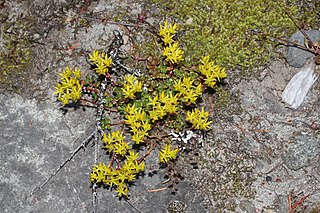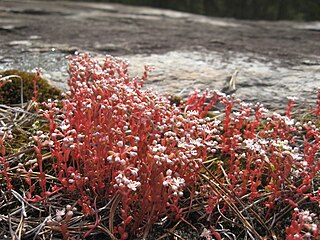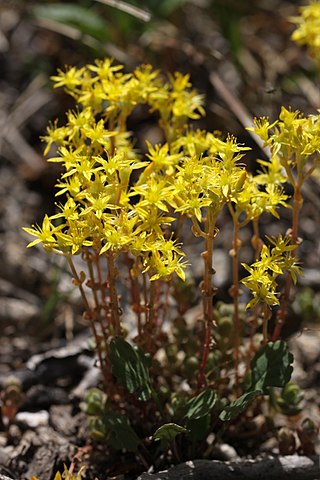
Sedum is a large genus of flowering plants in the family Crassulaceae, members of which are commonly known as stonecrops. The genus has been described as containing up to 600 species, subsequently reduced to 400–500. They are leaf succulents found primarily in the Northern Hemisphere, but extending into the southern hemisphere in Africa and South America. The plants vary from annual and creeping herbs to shrubs. The plants have water-storing leaves. The flowers usually have five petals, seldom four or six. There are typically twice as many stamens as petals. Various species formerly classified as Sedum are now in the segregate genera Hylotelephium and Rhodiola.

Echeveria is a large genus of flowering plants in the family Crassulaceae, native to semi-desert areas of Central America, Mexico and northwestern South America.

Petrosedum rupestre, also known as reflexed stonecrop, Jenny's stonecrop, blue stonecrop, stone orpine, prick-madam and trip-madam, is a species of perennial succulent flowering plant in the family Crassulaceae, native to northern, central, and southern Europe.

Sedum oreganum is a species of succulent plant of the genus Sedum. It grows along the Pacific Coast of North America from Alaska to far northern California. The plant, known by the common name Oregon stonecrop, grows in many types of rocky habitat, including coastal bluffs and cliffs and the talus of higher inland mountains.

Hylotelephium telephium, known as orpine, livelong, frog's-stomach, harping Johnny, life-everlasting, live-forever, midsummer-men, Orphan John and witch's moneybags, is a succulent perennial groundcover of the family Crassulaceae native to Eurasia. The flowers are held in dense heads and can be reddish or yellowish-white. A number of cultivars, often with purplish leaves, are grown in gardens as well as hybrids between this species and the related Hylotelephium spectabile (iceplant), especially the popular 'Herbstfreude'. Occasionally garden plants may escape and naturalise as has happened in parts of North America.

Rhodiola is a genus of perennial plants in the family Crassulaceae that resemble Sedum and other members of the family. Like sedums, Rhodiola species are often called stonecrops. Some authors merge Rhodiola into Sedum.

Orobanche uniflora, commonly known as one-flowered broomrape, one-flowered cancer root, ghost pipe or naked broomrape, is an annual parasitic herbaceous plant. It is native to much of North America, where it is a parasitic plant, tapping nutrients from many other species of plants, including those in the families Asteraceae and Saxifragaceae and in the genus Sedum. The name "orobanche" can be translated to "vetch-strangler" and "uniflora" can be translated to "single-flower".

Phedimus spurius, the Caucasian stonecrop or two-row stonecrop, is a species of flowering plant in the family Crassulaceae. It is still widely listed in the literature as Sedum spurium.

Diamorpha is a genus of plants in the family Crassulaceae. It is sometimes included within the genus Sedum. It is monotypic, including only the species Diamorpha smallii, an endemic of the southeastern United States. It becomes active in late fall and winter, blooms in late March, then dies. It has red succulent leaves that act to reflect light and hold water. Diamorpha smallii is found primarily on solution pools, shallow basins on rocky outcrops that contain seasonal pools. The plant is mainly found in Georgia, though populations have also been noted in Alabama, South Carolina, North Carolina, Tennessee, and Virginia. It is listed as an endangered species by the Tennessee Department of Environment and Conservation.

Hylotelephium is a genus of flowering plants in the stonecrop family Crassulaceae. It includes about 33 species distributed in Asia, Europe, and North America.

Sedum ternatum is the most widespread native Sedum species in eastern North America, commonly known as woodland stonecrop. It has white flowers, blooming April to May. This shade-tolerant species is often found in the forest understory, although it can also grow in sunnier locations when sufficient moisture is present. Its common name of "stonecrop" evokes its ability to thrive atop boulders, where its succulent leaves help it to retain moisture in shallow soil. It adapts well to garden use.

Sedella is a small genus of annual flowering plants in the family Crassulaceae. There are approximately 7 species, all native to California, United States, one with a distribution extending into Oregon. These are petite succulent plants growing a few centimeters tall and bearing tiny yellowish or brownish flowers. Mock stonecrop is a common name for these plants.

Sedum debile, commonly called orpine stonecrop or weakstem stonecrop, is a low growing carpet forming flowering plant species of the genus Sedum in the family Crassulaceae.

Sedum spathulifolium is a species of flowering plant in the family Crassulaceae known by the common names broadleaf stonecrop, yellow stonecrop, and spoon-leaved stonecrop. An evergreen perennial, it is native to western North America from British Columbia to southern California, where it can be found often in shade in many types of rocky habitat in coastal and inland hills and mountains.

Sedum anglicum, the English stonecrop, is a species of flowering plant in the genus Sedum in the family Crassulaceae.

Sedum villosum, known as the hairy stonecrop or purple stonecrop, is a biennial to perennial flowering plant. Its leaves, which are 3–8 mm (0.1–0.3 in) long and may be reddish in colour, are generally covered with hairs, although S. villosum var. glabratum may have hairless leaves. Individual flowers have five pink petals, each up to 5 mm (0.2 in) long.

Sedum hispanicum, the Spanish stonecrop, is a species of plant in the family Crassulaceae.

Sedum nuttallii, the yellow stonecrop, is a species of flowering plant in the family Crassulaceae, native to the central United States. An annual, it is typically found growing in thin soils that form over sandstone or granite.


















